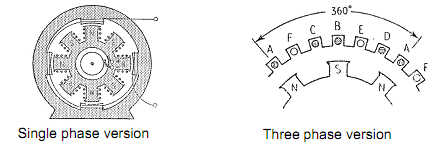If the stator windings of an alternator were to be supplied by an AC of frequency f (as opposed to drawing an AC current from them as would be the case for an alternator) then the machine would run as a motor at one speed - that at which it would produce a frequency f if used as an alternator. This is known as the synchronous speed and the machine when used as a motor is called a 'synchronous motor'. The synchronous speed may be deduced from the equation for the frequency of the generated voltage for an alternator.
The speed of rotation is given by n = 60 x f/p rpm where p = number of pole pairs on the stator (recall that in an alternator the rotor is supplied by DC).

If the stator windings of the AC alternator were energised by AC, then the machine would work as a motor instead, provided the rotor was turning
at exactly the right speed so that each time a rotor pole approached a stator winding, the field direction in that winding was such that a torque is produced in the direction of motion.
The main problem with this type of motor is running it up to the synchronous speed in the first place. If it is not very close to the synchronous speed, it will not turn at all.
An auxiliary motor is required to achieve the synchronous speed, after which the main motor can take over. The auxiliary motor can be made integral with the synchronous motor
Because of these starting problems, it has limited use, mainly applications that do not require the motor to start and stop very often. More recently, this problem can be overcome by using modern power electronic drives that ramp up the frequency of the supply.